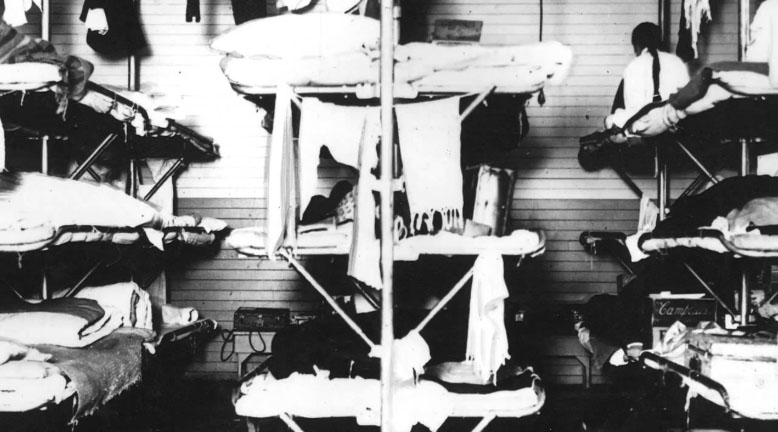The cultural history of Angel Island is marked by diverse inhabitants and experiences. Ranging from hunting grounds for the Coastal Miwok, a west coast quarantine and immigration portal, a Nike Missile battery, and even a picnic paradise—Angel Island has been marked by a kaleidoscope of human activities. As a State and National Historic Landmark, AISP must steward the island’s cultural landscapes and stories.
Coastal Miwok People

|

The Hookooeko Tribe of the Coast Miwok group has inhabited portions of what is today Marin County since around 4000 BC. They settled in Marin County and Angel Island around 1000 AD, migrating between settlements on the mainland and the island depending on seasonally available resources.
Typically they used the island as temporary summer hunting villages. Archaeological evidence tells us they stayed at Ayala Cove, Point Stuart, Quarry Beach, and the US Immigration Station. A Hookooeko settlement also existed near China Cove on the northeast corner of Angel Island from 1000 AD until the late 1700s.
China Cove was an ideal spot due to its sheltered location, abundance of food resources, proximity to fresh and salt water, and the natural landing area between the east and west slopes.
The Hookooeko appear to have used the site continuously for about 800 years until the arrival of European settlers. Today, the modern descendants of the Coast Miwok have federal recognition as Federated Indians of Graton Rancheria. This tribe includes descendants of indigenous people living in Marin and Sonoma counties during the eighteenth to twentieth centuries” (Davison & Meier, 2002 13-18).
Spanish and Mexican Era

|
By 1775, the Spanish had established five missions in Alta California, and the Spanish Viceroy of Mexico sent Lt. Don Juan de Ayala bring supplies to Monterey and chart San Francisco Bay. Ayala anchored his ship, the San Carlos on the island on August 13, 1775, and named it Isla de Los Angeles. Today, the main port of entry to Angel Island is named in his honor, Ayala Cove.
During this period, Ayala Cove became a stop for passing ships to gather wood and replenish water supplies.
In 1839, Don Antonio Maria Osio became the only "owner" of the island receiving it as a land grant from the Mexican government. He constructed several permanent structures, including two dams, farmhouses, a herder’s house, and a sandstone quarry while grazing his cattle on the island. As California joined the Union, the US Navy took possession of Angel Island, attempting to evict Osio. He placed caregivers on the island and fought this in court, actually winning in 1856. However the ruling was appealed to the Supreme Court, and Osio lost the land for good in 1860.
Quarantine Station

|
Since the 17th century, governments have quarantined foreign ships to prevent the spread of disease. Quarantine regulation the responsibility of state governments until the close of the 19th century.
In 1889, the War Department transferred land at Ayala Cove to the Treasury Department so that a Quarantine Station could be established. Here medical staff treated victims of smallpox, bubonic plague, and other contagious diseases.
The first passengers quarantined in Ayala Cove were from the steamship China in 1891. By the following year, the station had re-purposed a ship, the Omaha, to fumigate potentially contaminated ships.
From 1892 to 1925, over 45 buildings were built including a two-story bathhouse, a hospital, a laboratory, barracks, laundry, a segregated dining area for Asian detainees, a disinfecting shed, and a crematory. The last detainees were treated in 1935.
However, during World War I and World War II, the Quarantine Station housed prisoners of war andstayed in operation until 1946.
United States Immigration Station

|

The United States Immigration Station (USIS) on Angel Island was the principal West Coast port of entry for immigrants to the US between 1910 and 1940, and was nicknamed “the Guardian of the Western Gate.” Hundreds of thousands of immigrants from more than 80 countries were processed at the station during the 30-year period.
Chinese immigrants specifically were excluded from immigrating to the U. S. by the Chinese Exclusion Act of 1882 and were typically treated differently than immigrants from other countries. Most of the 175,000 Chinese arriving at Angel Island were detained on average for two weeks while their applications were given extra scrutiny. However several detainees waited far longer, with stays of 22 and 23 months.
While the predominant immigrant groups of detainees were Asian, many Europeans were quarantined on Angel Island for health reasons or if their immigration status was uncertain. The Asian and European immigrants were housed separately, ate different meals, and were treated differently.
Some of the detainees, especially the Chinese, expressed their feelings by carving and writing on the walls of the Detention Barracks and the Hospital. They created images, left messages or wrote poems. The carvings have become a poignant symbol of the site’s cultural history and are still visible today.


On August 12, 1940 a fire destroyed the Administration Building at the Immigration Station. At this time most of the remaining detainees were moved to various locations on the mainland, including the county jail. The Angel Island property was ultimately declared surplus on December 9, 1940 (Davison and Meier, 89-93) and was turned over to the Army.
Now called “North Garrison”, the station found new life as a detention facility for Prisoners of War during WWII. The first prisoners held at North Garrison were Japanese. Germans and Italians were held there temporarily until they could be transported to inland camps. Later, the prisoners were Japanese, Koreans, and Okinawans.
Our Community. Our Island. Our Legacy.
Angel Island Conservancy// PO Box 866 / Tiburon / CA 94920// info@angelisland.org// Tax ID No. 51-0152954// FACEBOOK// FLICKR// INSTAGRAM